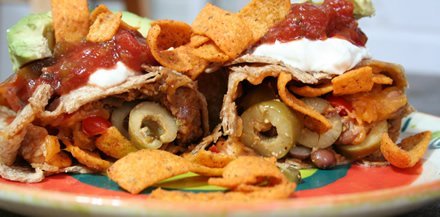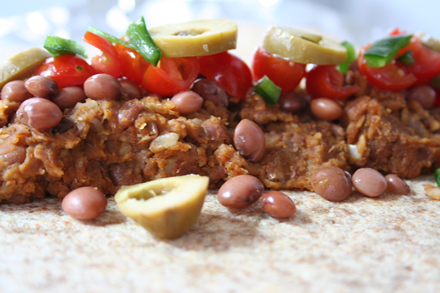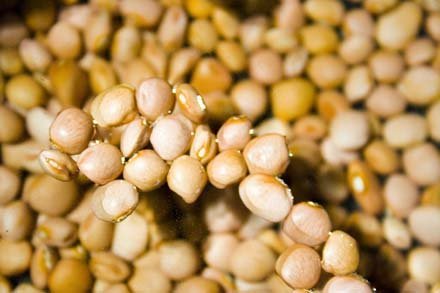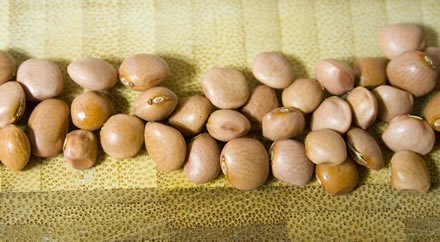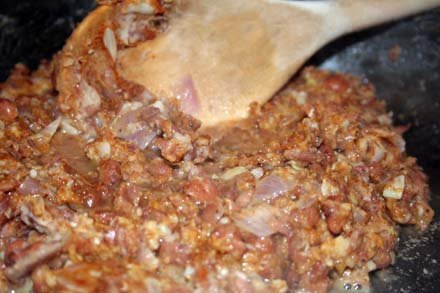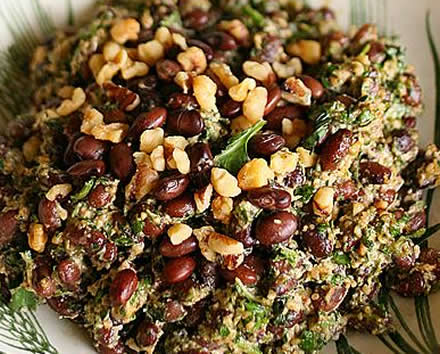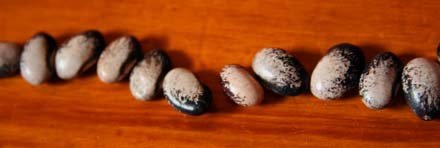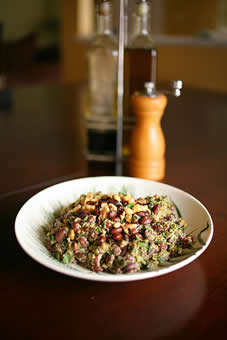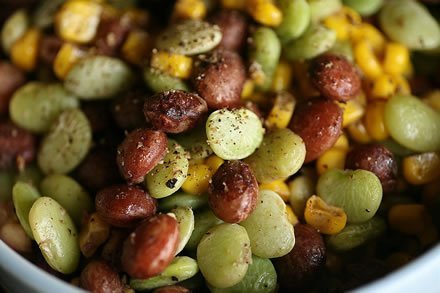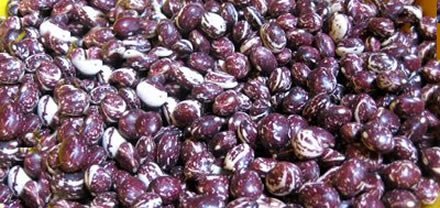
Do you wish you could trick your kids into eating healthy when they think they’re getting away with chocolate mayhem? Trying to get your nephew to branch out into food groups beyond Ding Dongs and Twizzlers? Wanna pull one over on your spouse, who is more committed to the cookie jar than he is to the remote control?
Well don’t feed them these cupcakes.
These velvety, rich mouthfuls are to cupcakes what Morningstar ‘nicken nuggets are to McD’s. Or what Silk is to milk. Wonderfully tasty and satisfying – and nearly guilt-free — but, well, they’re no Little Debbies. They’re dense and textured, like a deep
I fed these cupcakes to my 7 year old niece. True, she a) is not an adventurous eater and b) knew they were suspect to begin with, because of the way that everyone was snickering when they encouraged her to have a cupcake or two. She took a bite. With a solemn expression and in a low voice, she delivered her verdict. “Aunt Becky? These taste a little like dirt.”
Well then. Would you like a glass of soymilk with that?
On the other hand, I took a tray of these to work. My office mates scarfed them down with nary a gag nor any shout of “imposter!” Maybe these are grown up cupcakes.
Before I move on to the recipe, let me ask you: what strange concoctions have you whirled together in the kitchen and passed off on the unsuspecting? Or, what have you tried but failed to pull off? Mostly I’m interested in healthy versions of guilty pleasures, but I’m up for any unlikely substitution.
Face it. Soymilk doesn’t pretend to be dairy-derived, and portabellas on the grill can’t pass as beef. That’s no crime against either.
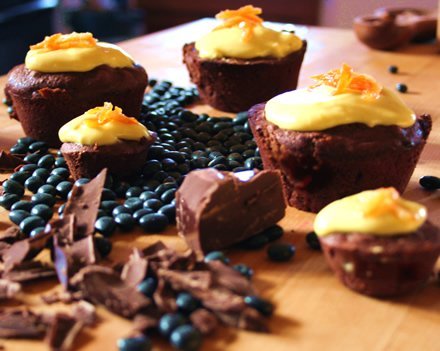
The Recipe
These cupcakes are a gallimaufry of unexpected ingredients, all of which add up to a complex and sometimes rebellious personality. There’s a heavy dose of dark chocolate here, which always makes me feel like I’m getting away with something. That, in combination with the beans, yields a silky, luxurious texture. Something happens though with the addition of oranges, lending the final product a spongy, moist quality. I used the brightest, tartest oranges I could find – they were almost too tart for straight eating. If the oranges available at your market are dull and drying right now (as I fear they might be, given the season), you might do half orange, half lemon.
Spontaneously, I tossed in some cranberries. I’d picked them up at Trader Joe’s – Omega 3 enhanced. Did they grass-feed them I wonder? I’m always on the search for ways to get my essential fatty acids, other than mercury-rich fish. The cupcakes seemed to like them.
The main ingredient is the beans, a shiny heirloom called Black Valentine. I am pleased to announce yet another source of heirloom cooking beans — Purcell Mountain Farms. Not everything they offer is heirloom, but like these Black Valentines, they do carry quite a few, and their total bean offering is somewhere over 100 varieties (not to mention the peas and lentils).
The Black Valentine is plump and creamy when cooked, more so than the typically drier black bean, which makes them as ideal for cupcakes as any bean can be. The variety has been around since before 1850, and was commercially released by Peter Henderson (whose name is on a lot of heirloom seeds) in 1897. The stringless Black Valentines can also be eaten green.
If you’re interested in growing them, they are available in seed packets from Baker Creek Heirloom Seeds and Victory Seeds.
I made a simple sour cream frosting to top these guys – the slight acidity of the cream complements that of the citrus, while the fat smooths out the flavors. I also made candied citrus peel as a final decoration. The longer the citrus peel sits, the sweeter it becomes.
If you want to modify these cupcakes so they’re more like a sweet confection than a velvety dessert, I’d suggest doubling the sugar and opting for a sweeter, non acidic cream cheese frosting. To make them closer to kid-friendly, you might leave out the citrus and berries all together. The heavy dark chocolate makes them rich and dense, so to lighten it up you can reduce the melted chocolate by about 1/3 and instead stir in chocolate chips and a dash of cinnamon.
Black Bean Cupcakes
12 ounces high-quality dark chocolate
5 tablespoons butter
1 teaspoon milk
1 ½ small oranges
Zest from 2 oranges
1 ¾ cups cooked Black Valentine beans
1/3 cup water
4 eggs
1 cup granulated sugar
1 teaspoon pure vanilla extract
1 teaspoon lemon or orange extract
1 ¼ teaspoons baking powder
¾ teaspoon salt
1 ¾ cups flour
1/3 cup chopped walnuts
1/3 cup dried cranberries
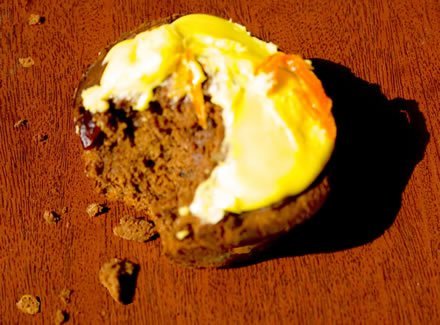
Preheat oven to 350 degrees. Spray muffin tins (12 large, 24 mini, or any combination thereof) with cooking oil.
Place chocolate, milk and butter in a microwavable container. Microwave in 30 second increments, stopping to stir ingredients, until melted and smooth. Set aside.
With a grater, remove zest from the oranges, being careful not to collect any of the bitter pith. Then remove the pith from the oranges and cut 1 ½ of the oranges into pieces. Place zest and orange in food processor. Add the water and process until smooth. Add the eggs, sugar, vanilla and citrus extract and process again until smooth. Pour mixture into large bowl, and fold in the melted chocolate.
In a small bowl, combine the flour, baking powder and salt. Stir this into the wet ingredients, mix well, and then add the walnuts and cranberries, stirring just until blended.
Spoon the mixture into muffin cups. Bake until a toothpick inserted into the center of the cakes comes out clean. Large cupcakes will take about 30 minutes, and mini cakes will finish in about 15.
When cupcakes cool, frost with sour cream icing and garnish with candied orange peel.
Sour Cream Frosting
3 tablespoons butter, softened
3/4 cup sour cream
1/2 teaspoon vanilla extract
1/2 teaspoon lemon extract
3 cups confectioners’ sugar
In a medium bowl, mix together the butter, sour cream, vanilla, lemon juice and salt. Stir in confectioners’ sugar, and beat with an electric mixer until smooth. For the bright yellow color, I added food coloring — your choice.
Candied
Peel from 2 oranges
2/3 cup water
1/2 cup sugar
1 tablespoon apple cider vinegar
Using vegetable peeler, remove rind from oranges in strips, being careful to avoid the white pith. Cut rind into matchstick strips. Place in small saucepan and cover with water. Bring to boil, then immediately drain and rinse with cold water. Drain again.
Combine 2/3 cup water, sugar, and vinegar in medium saucepan. Bring to simmer, stirring to dissolve sugar. Add orange strips; and simmer for about 10 minutes, until orange peel is translucent. Drain and cool.

